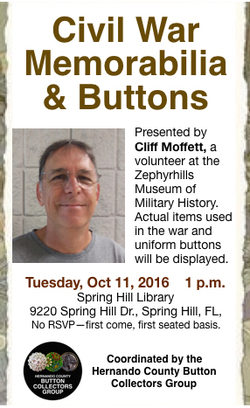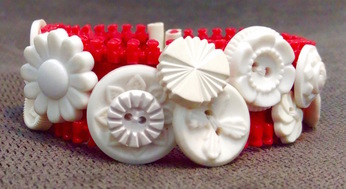| Earlier this year, I created the Button Lovers & Collectors Survey, and learned three top things button club members want for their clubs. I also heard what non-club members said they needed to consider joining a club. I am incorporating what I learned from all the answers into my presentation: "How to Market Your Button Club to Increase Membership," which I will be presenting at 3 p.m. Saturday, January 14, at the Florida State Button Society Meeting & Show. I hope that if you will be attending the show, you will come to hear more on this important topic! |
|
1 Comment
I have been busy creating new button/zipper bracelets this week. This first one was for a friend who picked out some of her favorites from a collection of buttons she bought 30 years ago. I think she chose some beautiful buttons and the bracelet turned out well! These other two I made from buttons I bought that aren't really collectible, but are great for craft projects. I was also pretty tickled that I found a large bright red zipper at a thrift store that was perfect as a backdrop for the white buttons!
Below is a list of categories from which you can choose a favorite button(s) to bring for
"Show 'N Tell" at our meetings. If there is not a website link with the description, you can try google-ing the term and add the word "images" to find photos of the type. This site is quite lovely and has some great photos as well: www.grandmothersbuttons.com/blog/wp-content/uploads/2014/05/gran_fieldguide_web2011.pdf Remember, you can also bring buttons that feature designs that include: Dogs, donkeys, dice and Easter, elephants, emblems and other "d" and "e" words. D. Evans & Co.: Manufacturers of brass and dress brass buttons (1848-1942). Look for their name on the back of a button. www.treasurenet.com/forums/what/324871-help-dating-button-backmark-d-evans.html Daguerreotype: This early photographic method used mostly for portraits is occasionally found on buttons. www.metmuseum.org/toah/works-of-art/2005.100.78/ Damask: Fabric generally with a floral motif and occasional borders that fit the size of the button. Most common cloth colors are white, dark brown and black. www.morningdressguide.com/morning-coat/morning-coat-buttons/ Decal: Design transferred to a button from a printed paper, then fired and often further decorated by hand painting. Found on many porcelain buttons, as well as some bone, pearl and vegetable ivory. Deccan: "Made in Deccan" can be found on the backs of silver-colored buttons from the 1950s on. May also show the factory name from within seven states in India. www.pinterest.com/pin/463378249135462139/ Decoupage: Decoupaged buttons are mostly from 18th century have fine designs cut out and pasted on a button. May be covered with glass. Rare. Also available, 19th century smaller decoupage buttons with colored backgrounds and mid-20th century decoupage buttons made in studios. Dewdrops: Molded glass buttons with small round humps on underside that reflect through to the front. The humps may cover the back or be placed between flowers petals or stars. www.vintagebuttons.net/pwts.html Dickerson Hard Rubber Company: The backmark, D.H.R. Co. may be found on these rubber buttons. Simple designs on dull black buttons with 2 holes or self shank. Dorset: Thread buttons made in England from mid 18th to mid 19th centuries. Made by covering disks or rings with thread. www.buttoncountry.com/Fabrics1.html Eglomise: A type of reverse painting on glass buttons, starting with a layer of gold. Design was then etched out of the gold and than covered with black to show the design. Late 18th century. Electroplating: Using electrolysis, nickel, silver or gold was adhered to metal buttons. Also done on some plastics. Embedded: Molded glass (and other material) buttons with metal decorations inserted while glass or material was still soft. Embossed: Raised designs in leather or other soft materials. Embroidery: Raised and ornamental designs on buttons made through needlework. Used for several centuries beginning in the 17th. Enamels: Button material disk is laid with glass particles and then heated in a kiln to melt the glass and fuse it to button top. Can have foil or paint added. Many different techniques are used. www.buttoncountry.com/Enamels1.html Engraving: Fine lines of designs cut into button disk. Black may be added on engraved pearl or vegetable ivory buttons to make the design stand out. Stamped buttons may be mistaken for engraved buttons. Escutcheon: A metal ornament applied to the center of a button. Found in glass, vegetable ivory, horn, fabric and wood buttons. Most escutcheons are in realistic shapes like heads, animals, flowers and insects. Etched: Buttons with that are engraved through an etching wax and acid wash. Some question if this method was actually ever used for buttons. May have just been finely carved or molded designs. I just finished a button bracelet for a new friend. She had a collection from which she chose several special vintage buttons for me to work with. I love the button combination so much, I wish I could keep it!
 This upcoming program is a new member recruitment event being coordinated by Hernando County Button Collectors Group. By enpanding the content of the program -- but still including buttons as a topic -- we hope to attract both women and men. Partnering with our local library has always been a great way to increase our attendance. |
Sylvia Liszka Durell, AuthorOwner of HoleyButtons.com and a founding member of the Hernando County Button Collectors Group in Florida. Archives
June 2024
|






 RSS Feed
RSS Feed